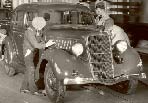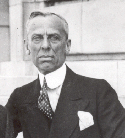
The Degradation of Work Revisited: Workers and Technology in the American Auto Industry, 1900-2000
More of the Same: The Rise of Sloanism and Flexible Mass Production
From World War I through the 1920s, Fordism became the global paradigm for efficient and profitable production. (In Germany, the new technological system was labeled Fordismus and in the Soviet Union, Fordizatsiia.) After World War I, Ford officials and managers embellished upon and refined the Highland Park methods and constructed the River Rouge plant, which concentrated and located all phases of automobile production into one huge industrial facility. The culmination of Fordist industrial principles, this massive plant ultimately employed as many as 80,000 workers. In the late 1920s, one Ford worker described its “new and more complicated conveyor system” as over two miles long. “This new mechanical monster with its tributaries of chains, belts and slides,” he added, “binds practically the whole plant together and automatically adjusts the speed of every worker. You must keep up with the belt or else the work piles up and the line gets clogged.”
Through the late 1910s and the 1920s, American auto and other manufacturers rapidly copied and adapted these Fordist methods and technologies in their industrial enterprises. By the 1920s, Ford no longer held an unequaled technological advantage over his automotive competitors as others speedily embraced and sometimes improved on Ford methods. Through the auto industrial age, despite some technological tinkering, the Fordist paradigm remained the bedrock foundation that shaped and formed the social contours of technology and work in the American automobile industry. For auto workers on the production and assembly lines, the brutal regime of monotonous and degraded work persisted.In the 1920s, the technical innovations of Sloanism characterized the further evolution of modern automotive production technology. This Sloanist transformation began in the recently reorganized General Motors Corporation. While the Ford system of mass production relied on the manufacture of a single model, Sloan hoped to compete with and to overcome the Ford market advantage through the introduction of fashion or style accompanied with the annual model change and through the establishment of several lines of automobiles, as he noted for “every purse and purpose.” With stylish automobiles, Sloan hoped to attract women as new purchasers and to introduce an early notion of planned obsolescence where owners would want to possess the very latest model. With a full line of models, he wanted to cover the market for the entire social spectrum, from the many owners of the lowly Chevrolet to the select few owners of the high-priced Cadillac.
This new marketing strategy called forth a new production strategy. The introduction of diverse models and continuously restyled models represented a major departure from the fundamental premise of Fordist mass production of a single model. A wide variation in the appearance of automobiles necessitated a much more flexible system of mass production. In 1921, A. J. Baker, a Willys-Overland engineer, offered a critique of the Fordist specialized machines that guided General Motors in the development of more flexible high-volume production. Although specialized machines met the needs of volume production, he maintained, they “faced the ever-present danger that a change of design may render the machine of no value what so ever.” To solve this technical problem, he called for a new middle-range machine that used the unskilled labor of the Ford single-purpose machine and contained some of the flexibility of the general purpose ones. Such a semi-special machine would require a skilled set-up man to readjust and to reset its parts or components for changes in design. But the machine operator who worked in a sequentially-arranged machine shop did not see any significant change in the character of work tasks and routines. For assembly line workers, the annual model change meant several days or weeks of fussing and fumbling until they adjusted to the new routines and rhythms of their work. Despite its flexible nature, the Sloanist system of production still rested on the foundation of Fordist principles of mass production.
<<Previous Section - Next Section>>
Labor under Mass Production: Ford and the Five Dollar Day
More of the Same: The Rise of Sloanism and Flexible Mass Production
Men at Work? Masculinity and Mass Production in the 1920s and 1930s
The Rise of the Unions and the Effects of World War II
Labor and the Post-War Automation Movement
The “Blue Collar Blues” of the 1970s
About the Project | Credits | Contact Us | Student & Teacher Resources | Site Map
©2004 Automobile in American Life and Society




